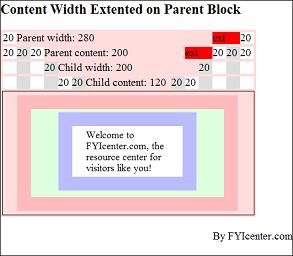|
Home >> Tutorials/FAQs >> CSS Tutorials >> Index
CSS Tutorials - Testing Parent Width Extension
By: FYICenter.com
(Continued from previous topic...)
How To Test Parent Content Width Extension?
One of the horizontal formatting rules says: If the width of the parent element is specified and less than the full width of the child stack.
the width of the parent element will be extended match the full width of the child stack.
The HTML and CSS document shows you a good example on this rule:
<html><head>
<style type="text/css">
H1 {font-size: 20px}
DIV.page {width: 425px; border: 1px solid black}
TABLE#out {background-color: #ffdddd}
TD#box {border: 1px solid black}
DIV#parent {width: 280px;
margin: 5px 20px 5px 20px;
border: 20px solid #ffbbbb;
padding: 5px 20px 5px 20px;
background-color: #ddffdd}
P#child {width: 200px;
margin: 5px 20px 5px 20px;
border: 20px solid #bbbbff;
padding: 5px 20px 5px 20px;
font-size: 14px;
background-color: #ffffff}
SPAN#parentWidth {width: 280px}
SPAN#parentContent {width: 200px}
SPAN#childWidth {width: 200px}
SPAN#child {width: 120px}
SPAN#w20 {width: 20px; background-color: #ffffff}
SPAN#g20 {width: 20px; background-color: #dddddd}
SPAN#ext {width: 40px; background-color: #ff0000}
</style>
</head><body><div class="page">
<H1>Content Width Extented on Parent Block</H1>
<table id=out><tr><td>
<span id=w20>20 </span>
<span id=parentWidth>Parent width: 280</span>
<span id=ext>ext </span>
<span id=w20>20 </span>
</td></tr><tr><td>
<span id=w20>20 </span>
<span id=g20>20 </span>
<span id=w20>20 </span>
<span id=parentContent>Parent content: 200</span>
<span id=ext>ext </span>
<span id=w20>20 </span>
<span id=g20>20 </span>
<span id=w20>20 </span>
</td></tr><tr><td>
<span id=w20> </span>
<span id=g20> </span>
<span id=w20> </span>
<span id=g20>20 </span>
<span id=childWidth>Child width: 200</span>
<span id=g20>20 </span>
<span id=w20> </span>
<span id=g20> </span>
<span id=w20> </span>
</td></tr><tr><td>
<span id=w20> </span>
<span id=g20> </span>
<span id=w20> </span>
<span id=g20> </span>
<span id=w20>20 </span>
<span id=g20>20 </span>
<span id=child>Child content: 120</span>
<span id=g20>20 </span>
<span id=w20>20 </span>
<span id=g20> </span>
<span id=w20> </span>
<span id=g20> </span>
<span id=w20> </span>
</td></tr><tr>
<td id=box><div id=parent><p id=child>
Welcome to FYIcenter.com, the resource
center for visitors like you!
</p></div></td>
</tr></table>
<p align="right">By FYIcenter.com</p>
<div></body></html>
Save this document as ChildBlockExtension.html, and view it with a browser,
you will see how the content width of the parent block is extended to meet the full width of the child block:

(Continued on next topic...)
- How Many Ways Can Elements Relate to Each Other?
- How In-line Elements Are Formatted Side by Side?
- How Nested Block Elements Are Formatted?
- How Two Block Elements Are Formatted as a Stack?
- How Floating Elements Are Formatted?
- Why Is the Top Margin Not Showing?
- How Are Vertical Margins between Two Block Elements Collapsed?
- How Are Parent Padding Spaces Collapsed with the Child Margins?
- How Is the Width of a Parent Element Related to Child Elements?
- How Is the Full Width of a Block Element Extended?
- How To Test Child Full Width Extension?
- How To Test Parent Content Width Extension?
- What Are White Spaces in HTML Documents?
- How White Spaces Are Formatted?
- What Happens to Multiple White Spaces in In-line Elements?
|